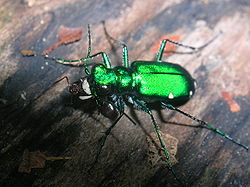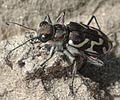Cicindela
| Cicindela | |
|---|---|

| |
| Cicindela sexguttata | |
| Scientific classification | |
| Kingdom: | |
| Phylum: | |
| Class: | |
| Order: | |
| Suborder: | |
| Family: | |
| Subfamily: | |
| Tribe: | |
| Genus: | Cicindela Linné, 1758
|
| Type species | |
| Cicindela campestris | |
| Subgenera and species | |
|
Many (see List of Cicindela species). | |

Cicindela, commonly known as common tiger beetles [1] are generally brightly colored and metallic beetles, often with some sort of patterning of ivory or cream-colored markings. They are most abundant and diverse in habitats with sandy soil (though some prefer clay), and very often near bodies of water, even if seasonally transient; along river, sea and lake shores, on sand dunes, around playa lakebeds and on clay banks or woodland paths.
Etymology
The word "Cicindela" comes from the Latin word "cicindela", meaning "glowworm". This comes from the fact that members of the genus Cicindela are metallic and sometimes flashing. [1]
Systematics
The genus Cicindela is (in its broadest historical sense) the largest genus of tiger beetles, and they occur worldwide. The status of the genus is constantly in a state of flux, as various authorities on different continents have vastly different opinions about which (if any) of the dozens of subgenera traditionally recognized within the genus are deserving of being accorded status as independent genera. Moreover, this is one of the few insect taxa in which the rank of subspecies has traditionally been used repeatedly, and essentially no two classifications consistently treat the various members of the genus as to which are species and which are subspecies.
Treated as a single genus, and even with a fairly conservative estimate of species, there are over 850 [2] (or even up to 2,300) species in the group [3] (thus being almost equal to the subtribe Cicindelina (W.Horn, 1908), with several thousand published names applied, collectively. Currently most of the subgenera below are in fierce dispute, being considered genera of their own by some, and subgenera of the genus Cicindela by others. The genus is divided into the following subgenera:
- Cicindela (Ancylia)
- Cicindela (Archidela)
- Cicindela (Austrocicindela)
- Cicindela (Brasiella)
- Cicindela (Calochroa)
- Cicindela (Cephalota)
- Cicindela (Chaetodera)
- Cicindela (Cicindela)
- Cicindela (Cicindelidia)
- Cicindela (Cylindera)
- Cicindela (Duponti)
- Cicindela (Euzona)
- Cicindela (Fulgoris)
- Cicindela (Habroscelimorpha)
- Cicindela (Hypaetha)
- Cicindela (Jansonia)
- Cicindela (Lophyridia)
- Cicindela (Macfarlandia)
- Cicindela (Micromentignatha)
- Cicindela (Myriochile)
- Cicindela (Neolaphyra)
- Cicindela (Opilidia)
- Cicindela (Pachydela)
- Cicindela (Pancallia)
- Cicindela (Rivacindela)
- Cicindela (Sophiodela)
- Cicindela (Tribonia)
For a list of species, see List of Cicindela species. The subgenus Cicindela (Cicindela), or Cicindela sensu stricto contains the following species:
Gallery
-
Cicindela depressula ssp depressula
-
Cicindela chinensis
Notes
- ^ a b "Genus Cicindela". Bugguide. Retrieved January 21, 2015.
- ^ Cardoso, A, Vogler, A.P. DNA taxonomy, phylogeny and Pleistocene diversification of the Cicindela hybrida species group (Coleoptera: Cicindelidae). Molecular Ecology (2005) 14, 3531–3546
- ^ Proença,S.J.R,Cytogenetic variability in three species of the genus Cicindela (s.l.) (Coleoptera, Cicindelidae): Karyotypes and localization of 18S rDNA genes.Genetics and Molecular Biology, 27, 4, 555-560 (2004)
References
- Northeastern Tiger Beetles: A Field Guide to Tiger Beetles of New England and Eastern Canada by Jonathan G. Leonard and Ross T. Bell. CRC Press (1999).
- Tiger Beetles of Alberta: Killers on the Clay, Stalkers on the Sand by John Acorn. University of Alberta Press, 2001.
- Tiger Beetles: The Evolution, Ecology, and Diversity of the Cicindelids by David L. Pearson and Alfried P. Vogler. Cornell University Press, 2001.
- A Field Guide to the Tiger Beetles of the United States and Canada by David L. Pearson, C. Barry Knisley and Charles J. Kazilek. Oxford University Press, 2005.













